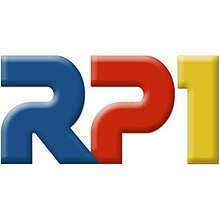DZRB-AM
 | |
| City | Quezon City, Philippines |
|---|---|
| Broadcast area | Mega Manila, surrounding areas |
| Branding | Radyo Pilipinas 1 (RP1) |
| Frequency | 738 kHz |
| First air date | May 1, 1933 |
| Format | News, Public Affairs/Talk, Government Radio, Entertainment, Music |
| Power | 50,000 watts |
| ERP | 100,000 watts |
| Callsign meaning | Radyo ng Bayan (Former Branding) |
| Former callsigns |
KZSO (1933-1944) KZFM (1944-1947) DZFM (1947-1987) |
| Former frequencies |
710 kHz (1933-1977) 918 kHz (1977-1996) |
| Owner | Philippine Broadcasting Service |
| Sister stations | RP2 1278, RP3 918, 87.5 FM1, 104.3 FM2, RP4 Radyo Pilipinas Worldwide |
| Webcast | DZRB Radyo Pilipinas 1 LIVE Audio |
| Website | PBS |
DZRB (738 AM) Radyo Pilipinas 1 (RP1) is an AM station owned and operated by Philippine Broadcasting Service in the Philippines. The station's studios are located in 4/F, PIA/Media Center Building, Visayas Avenue, Brgy. Vasra, Diliman, Quezon City, and its transmitter is located at Brgy Marulas, Valenzuela City. DZRB is the first radio station in the Philippines before the launch of DZRH. DZRB operates 20 hours daily (except during Maundy Thursday to Black Saturday annually) from 4 am to 12 mn.
On June 5, 2017, the former Radyo ng Bayan was rebranded as Radyo Pilipinas 1 (RP1).
History
On May 8, 1933, the United States-sponsored Insular Government established and operated radio station KZSO in the Philippines on the frequency of 710 kilohertz with a power of 10,000 watts through the United States Information Service. In 1944, the callsign was change to KZFM, named after Frederick Marquardt.
In September 1946, two months after the Philippines became an independent country from the U.S.A., KZFM was turned over to the Philippine government. With the transfer was born the Philippine Broadcasting Service, PBS the second broadcasting organization after Manila Broadcasting Company.
The station was first operated by the Department of Foreign Affairs until it was transferred to the Radio Broadcasting Board (RBB) which was created by President Manuel Quezon on September 3, 1937. Meanwhile, in the same year, an international telecommunications conference in Atlantic City, New Jersey, reassigned the letter "D" to replace the former "K" as the initial call letter for all radio stations in the Philippines. In January 1942, the RBB was abolished to give way to the establishment of the Philippine Information Council (PIC) which then assumed the function of the RBB, including the operation of DZFM. In turn, the PIC was abolished on July 1, 1952, and since then, until the creation of the Department of Public Information (DPI) in 1959, DZFM and the Philippine Broadcasting Service (PBS) had been operated under the Office of the President.[1]
During Martial Law, the Bureau of Broadcasts took over the station and became DPI Radio 1 / MPI Radio 1. In November 1978, due to the switch of the Philippine AM dial from the NARBA-mandated 10 kHz spacing to the 9 kHz rule implemented by the Geneva Frequency Plan of 1975, the station's frequency was transferred from 710 kHz to 918 kHz.
In 1986 (after the EDSA Revolution), DZFM returned to its ownership by the establishment of the Bureau of Broadcast Services via the reinstated PBS.


The station would later reformatted as Sports Radio. On March 1, 1996, however, Presidential Order No. 293 ordered the transfer of Sports Radio to 918 kHz, which led to the birth of the government's flagship station: Radyo ng Bayan (People's Radio) and it also transferred to 738 kHz frequency.[2]
During his first State of the Nation Address, President Rodrigo Duterte will pass a law merging PBS with its TV counterpart, People's Television Network into the "People's Broadcasting Corporation (PBC)".
PBS announced that Radyo ng Bayan & its provincial AM stations will have a major rebranding, merging with the "Radyo Pilipinas" brand by June 5, 2017. Radyo Magasin, Sports Radio and Radyo Pilipinas Worldwide will likely to be followed within this year as Radyo Pilipinas 2, Radyo Pilipinas 3 and Radyo Pilipinas 4, respectively.[3]
Platform
As the government's flagship radio station, it serves as a medium of development communication, a conduit between the government and the people, aiming to mobilize all sectors of society towards development and nationalism. Live government news is aired here.
Notable personalities
- Martin Andanar (PCOO Head and formerly from Radyo 5 and News5)
- Aljo Bendijo (formerly with DZMM, also with DZAR)
- Alex Santos (formerly with DZMM, also with DWIZ)
- Wilson Lee Flores
- Ben Tulfo (formerly from DZME, DWUN, and Radyo5)
- Erwin Tulfo (formerly from DZMM, DZXL, and Radyo5)
- Ramon Tulfo (formerly from DWIZ and DZIQ)
- Mocha Uson (PCOO Assistant Secretary, formerly with DZRH)
See also
References
- ↑ Tuazon, Ramon (April 30, 2015). "Government Media: Rewriting Their Image and Role". National Commission for Culture and the Arts. Retrieved April 14, 2017.
- ↑ Terrado, Reuben (May 15, 2016). "DZSR radio stays relevant in changing times by being PH sport's link to masses". Sports Interactive Network Philippines. Retrieved May 16, 2016.
- ↑ "PCOO E-Brochure" (PDF). Presidential Communications Operations Office. Retrieved June 26, 2017.
External links
- Media Ownership Monitor Philippines - Radio by VERA Files and Reporters Without Borders